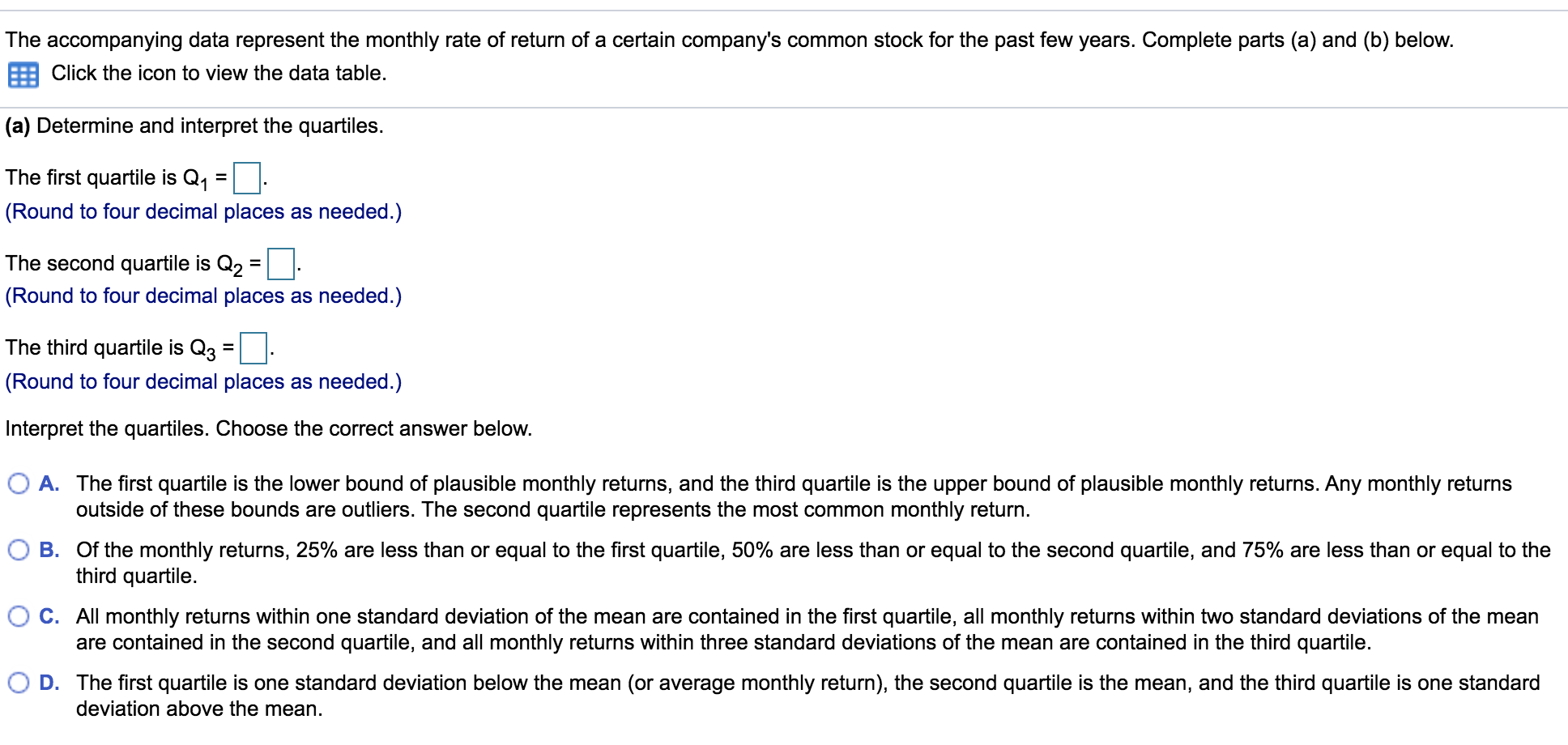The accompanying data represent the monthly rate of return of a certain company's common stock for the past few years. Complete parts (a) and (b) below. Click the icon to view the data table. (a) Determine and interpret the quartiles. The first quartile is Q1 = (Round to four decimal places as needed.) The second quartile is Q2 = (Round to four decimal places as needed.) The third quartile is Q3 %3D (Round to four decimal places as needed.) Interpret the quartiles. Choose the correct answer below. O A. The first quartile is the lower bound of plausible monthly returns, and the third quartile is the upper bound of plausible monthly returns. Any monthly returns outside of these bounds are outliers. The second quartile represents the most common monthly return. B. Of the monthly returns, 25% are less than or equal to the first quartile, 50% are less than or equal to the second quartile, and 75% are less than or equal to the third quartile. C. All monthly returns within one standard deviation of the mean are contained in the first quartile, all monthly returns within two standard deviations of the mean are contained in the second quartile, and all monthly returns within three standard deviations of the mean are contained in the third quartile. D. The first quartile is one standard deviation below the mean (or average monthly return), the second quartile is the mean, and the third quartile is one standard deviation above the mean.
The accompanying data represent the monthly rate of return of a certain company's common stock for the past few years. Complete parts (a) and (b) below. Click the icon to view the data table. (a) Determine and interpret the quartiles. The first quartile is Q1 = (Round to four decimal places as needed.) The second quartile is Q2 = (Round to four decimal places as needed.) The third quartile is Q3 %3D (Round to four decimal places as needed.) Interpret the quartiles. Choose the correct answer below. O A. The first quartile is the lower bound of plausible monthly returns, and the third quartile is the upper bound of plausible monthly returns. Any monthly returns outside of these bounds are outliers. The second quartile represents the most common monthly return. B. Of the monthly returns, 25% are less than or equal to the first quartile, 50% are less than or equal to the second quartile, and 75% are less than or equal to the third quartile. C. All monthly returns within one standard deviation of the mean are contained in the first quartile, all monthly returns within two standard deviations of the mean are contained in the second quartile, and all monthly returns within three standard deviations of the mean are contained in the third quartile. D. The first quartile is one standard deviation below the mean (or average monthly return), the second quartile is the mean, and the third quartile is one standard deviation above the mean.
Linear Algebra: A Modern Introduction
4th Edition
ISBN:9781285463247
Author:David Poole
Publisher:David Poole
Chapter4: Eigenvalues And Eigenvectors
Section4.6: Applications And The Perron-frobenius Theorem
Problem 22EQ
Related questions
Question

Transcribed Image Text:The accompanying data represent the monthly rate of return of a certain company's common stock for the past few years. Complete parts (a) and (b) below.
Click the icon to view the data table.
(a) Determine and interpret the quartiles.
The first quartile is Q1 =
(Round to four decimal places as needed.)
The second quartile is Q2 =
(Round to four decimal places as needed.)
The third quartile is Q3
%3D
(Round to four decimal places as needed.)
Interpret the quartiles. Choose the correct answer below.
O A. The first quartile is the lower bound of plausible monthly returns, and the third quartile is the upper bound of plausible monthly returns. Any monthly returns
outside of these bounds are outliers. The second quartile represents the most common monthly return.
B. Of the monthly returns, 25% are less than or equal to the first quartile, 50% are less than or equal to the second quartile, and 75% are less than or equal to the
third quartile.
C. All monthly returns within one standard deviation of the mean are contained in the first quartile, all monthly returns within two standard deviations of the mean
are contained in the second quartile, and all monthly returns within three standard deviations of the mean are contained in the third quartile.
D. The first quartile is one standard deviation below the mean (or average monthly return), the second quartile is the mean, and the third quartile is one standard
deviation above the mean.

Expert Solution
This question has been solved!
Explore an expertly crafted, step-by-step solution for a thorough understanding of key concepts.
This is a popular solution!
Trending now
This is a popular solution!
Step by step
Solved in 2 steps with 4 images

Knowledge Booster
Learn more about
Need a deep-dive on the concept behind this application? Look no further. Learn more about this topic, statistics and related others by exploring similar questions and additional content below.Recommended textbooks for you

Linear Algebra: A Modern Introduction
Algebra
ISBN:
9781285463247
Author:
David Poole
Publisher:
Cengage Learning

Glencoe Algebra 1, Student Edition, 9780079039897…
Algebra
ISBN:
9780079039897
Author:
Carter
Publisher:
McGraw Hill

Linear Algebra: A Modern Introduction
Algebra
ISBN:
9781285463247
Author:
David Poole
Publisher:
Cengage Learning

Glencoe Algebra 1, Student Edition, 9780079039897…
Algebra
ISBN:
9780079039897
Author:
Carter
Publisher:
McGraw Hill